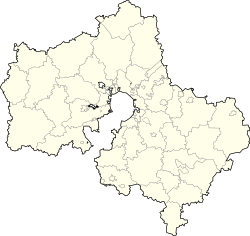Lobnya
| Lobnya (English) Лобня (Russian) |
|
|---|---|
| - Town - | |
 Location of Moscow Oblast in Russia |
|
|
|
|
|
|
|
|
|
|
| Administrative status (as of January 2013) | |
| Country | Russia |
| Federal subject | Moscow Oblast |
| Administratively subordinated to | Lobnya Town Under Oblast Jurisdiction |
| Administrative center of | Lobnya Town Under Oblast Jurisdiction |
| Municipal status (as of September 2008) | |
| Urban okrug | Lobnya Urban Okrug |
| Administrative center of | Lobnya Urban Okrug |
| Mayor | Nikolai Grechichnikov |
| Statistics | |
| Population (2010 Census) | 74,252 inhabitants |
| - Rank in 2010 | 216th |
| Time zone | MSK (UTC+03:00) |
| Founded | 1902 |
| Town status since | 1961 |
| Postal code(s) | 141730 |
| Dialing code(s) | +7 495 |
|
|
|
| on | |
Lobnya (Russian: Ло́бня) is a town in Moscow Oblast, Russia, located 30 kilometers (19 mi) north west of Moscow. Population: 74,252 (2010 Census);61,567 (2002 Census);60,475 (1989 Census); 30,000 (1970).
Lobnya was founded in 1902 and granted town status in 1961.
The German attack starting the Battle of Moscow (code-named ‘Operation Typhoon’) began on 2nd October 1941. The attack on a broad front brought German forces to occupy the village of Krasnaya Polyana (now in the town of Lobnya) to Moscow's North West. Krasnaya Polyana was taken on 30 November. This is accepted by many as the closest point occupied by German forces to Moscow. Less accepted is that this is the closest point visited by Germans to Moscow in the campaign.
Many sources state that at least one German army patrol visited nearby Khimki. Similarly many sources state Khimki as the closest point the Germans reached to Moscow (Khimki at the time was five miles from the edge of Moscow). Among the sources stating the Germans reached Khimki the details of the date and unit involved are inconsistent and disputed. One story of events asserts a skirmish took place in Khimki on 16 October at the Leningradskoe Shosse bridge involving a German motorcycle unit. Another account is a patrol reached Khimki around 30 November or early December before returning to its main unit without combat. The dates mentioned for this second account vary. A myth surrounding this is that the Germans would have been able to see the Kremlin in the distance from Khimki.
The Soviet Army counter offensive for "removing the immediate threat to Moscow" started on 5 December on the North-Western Front (the area around Krasnaya Polyana and Lobnya North West of Moscow). The South-Western Front and Western Fronts began their offensives on 6 December. The German forces were driven back. Moscow was never under such close land threat again during the war.
Within the framework of administrative divisions, it is incorporated as Lobnya Town Under Oblast Jurisdiction—an administrative unit with the status equal to that of the districts. As a municipal division, Lobnya Town Under Oblast Jurisdiction is incorporated as Lobnya Urban Okrug.
...
Wikipedia



